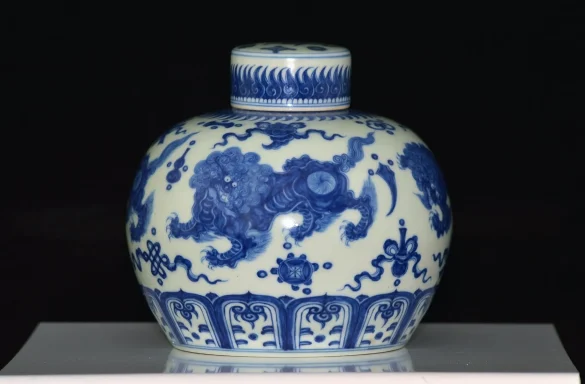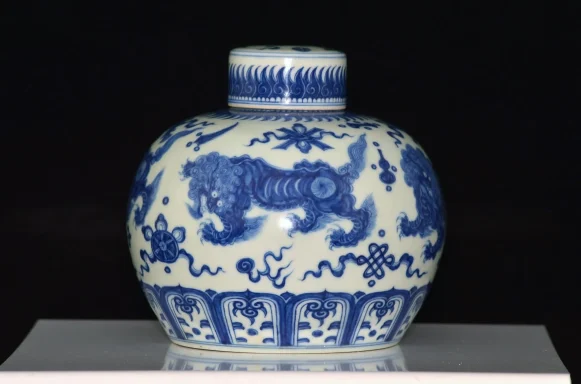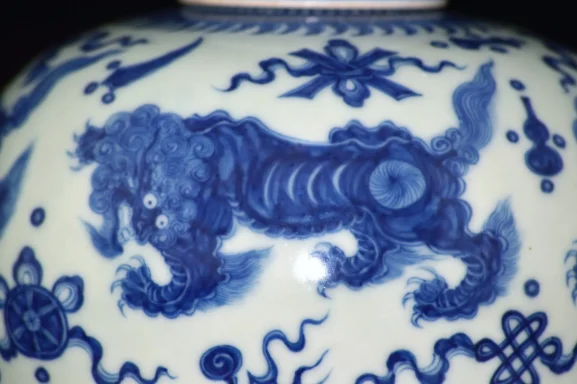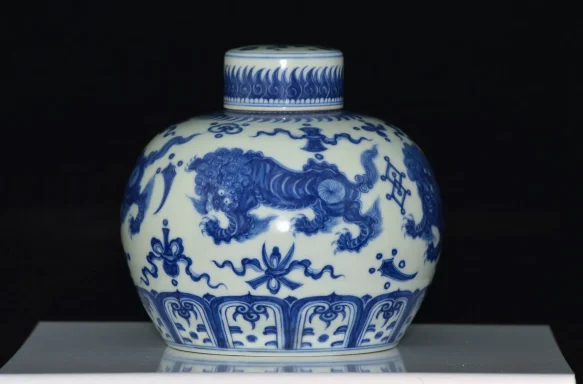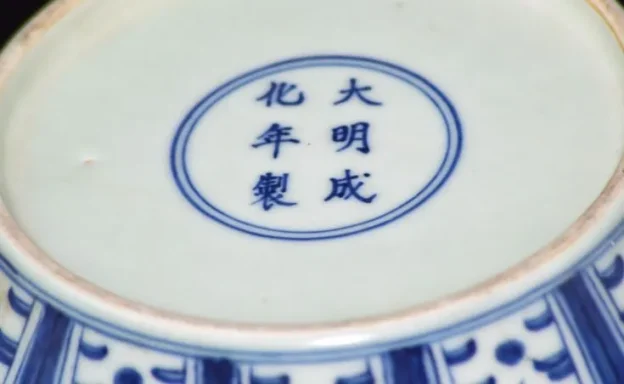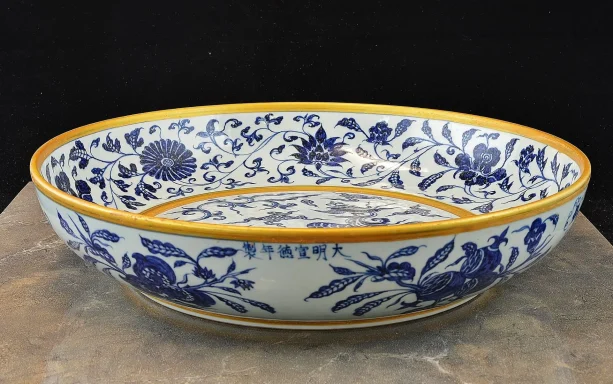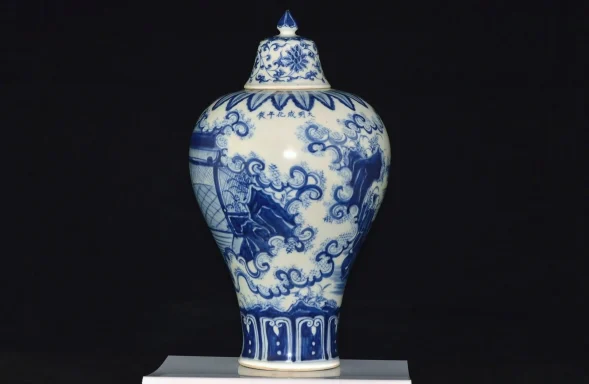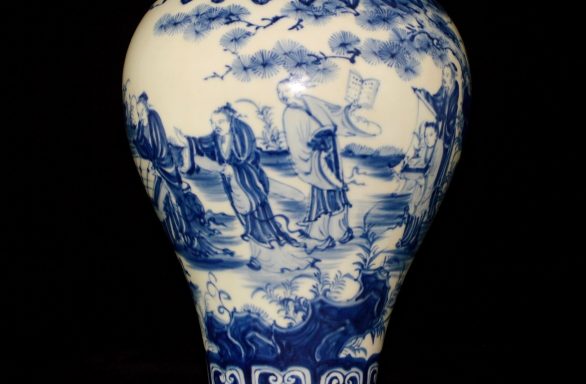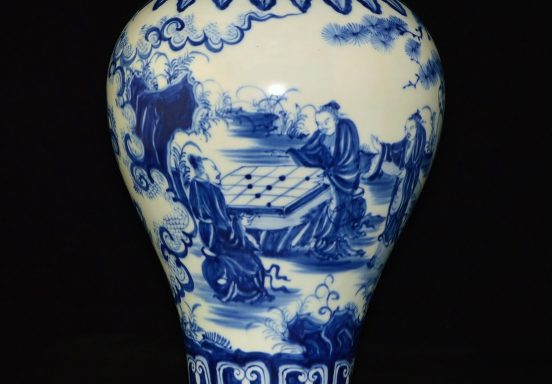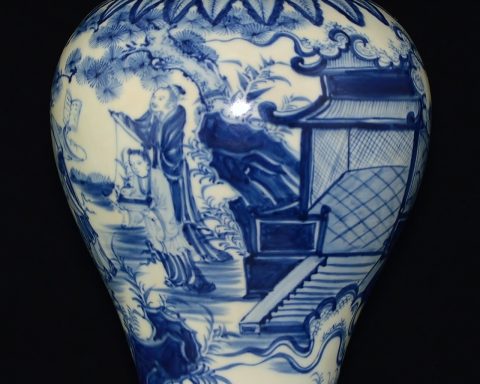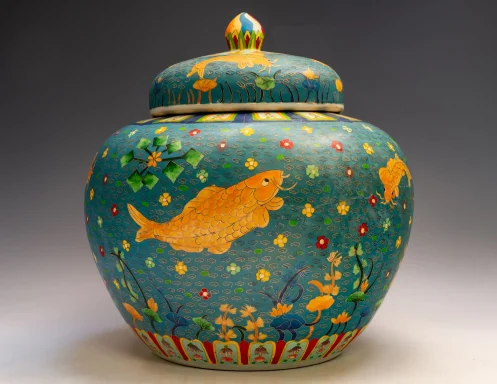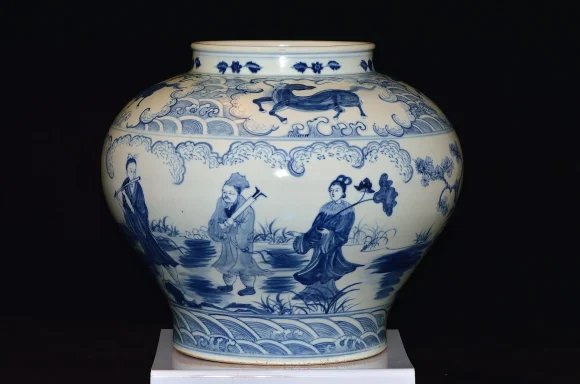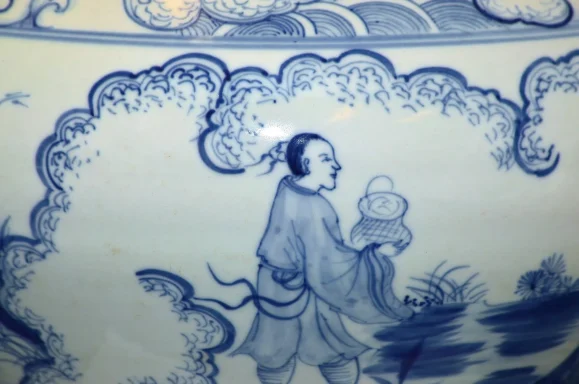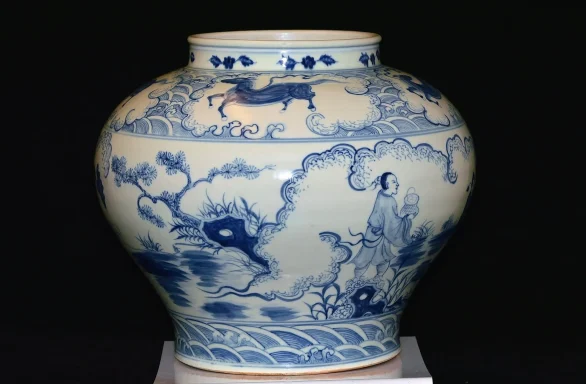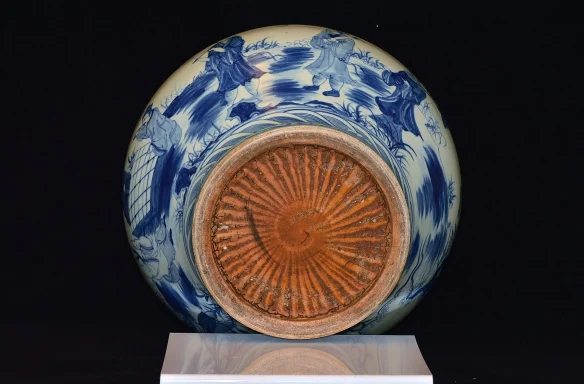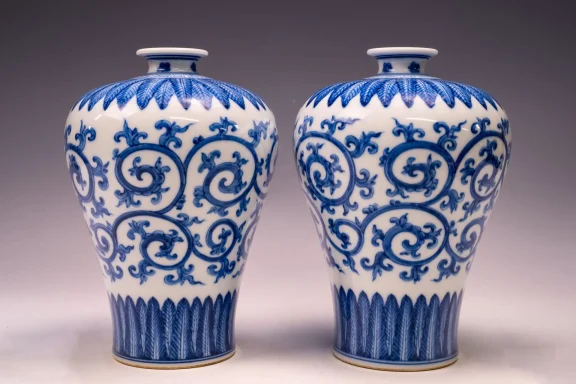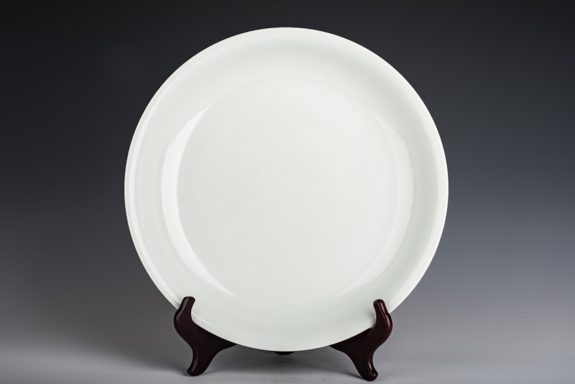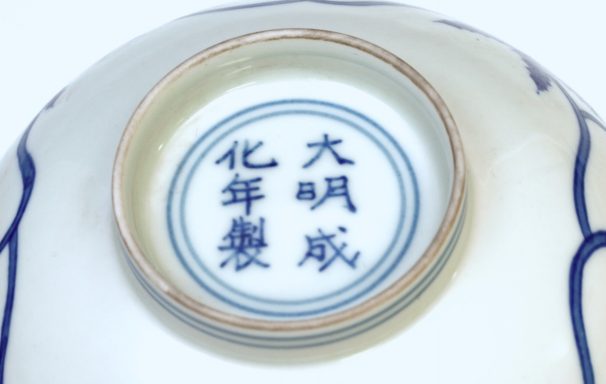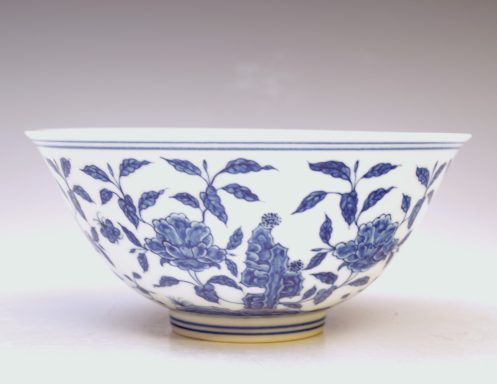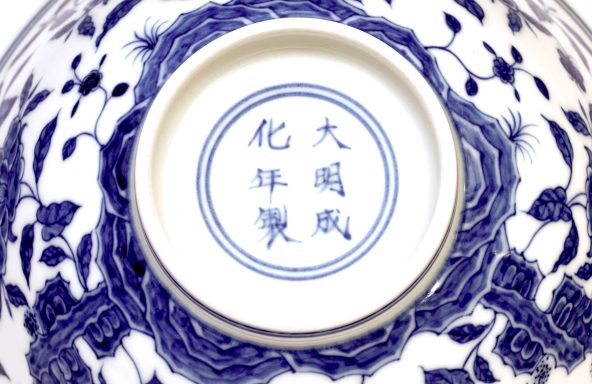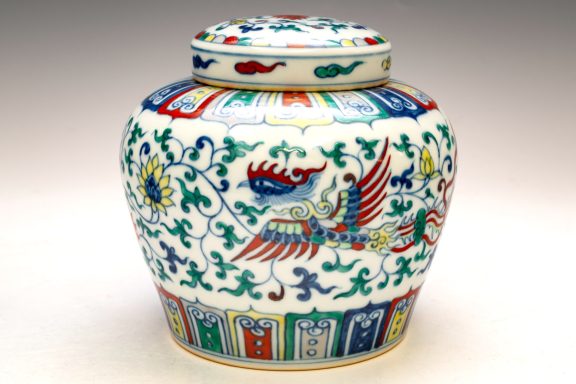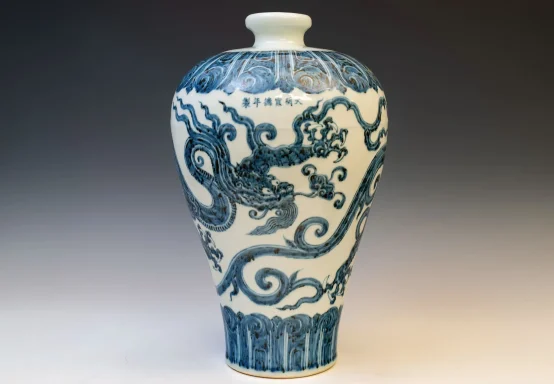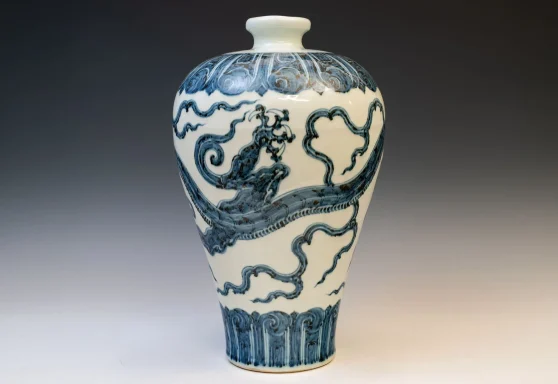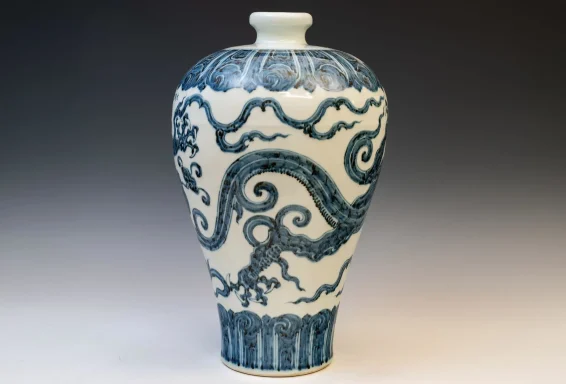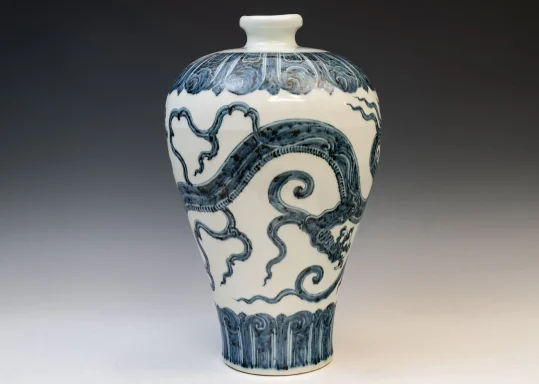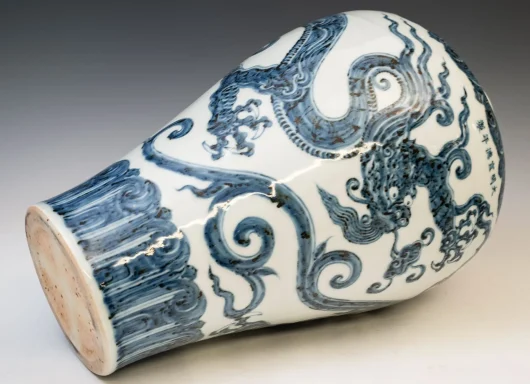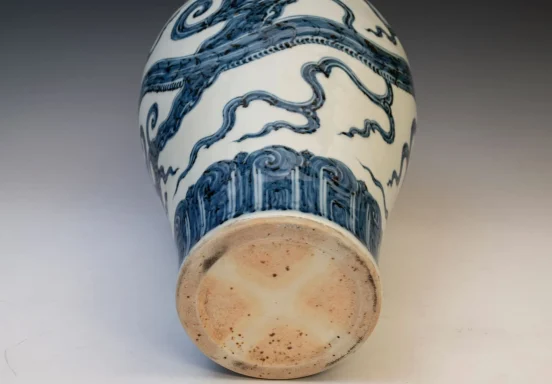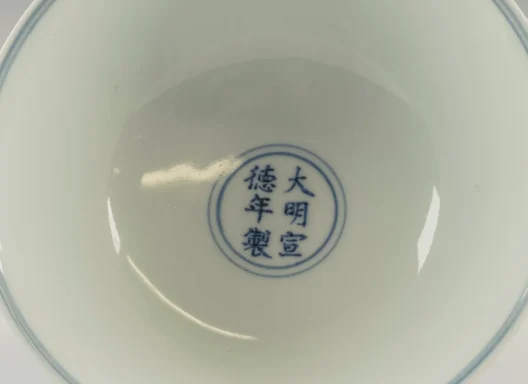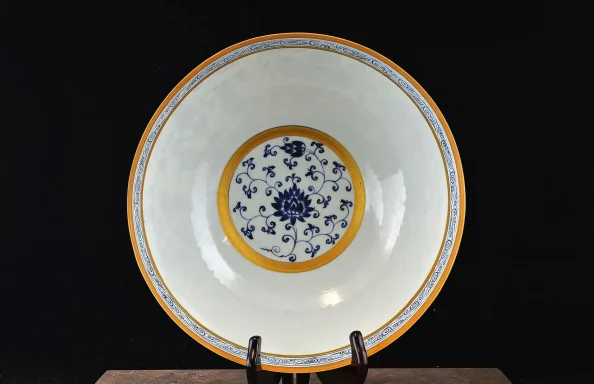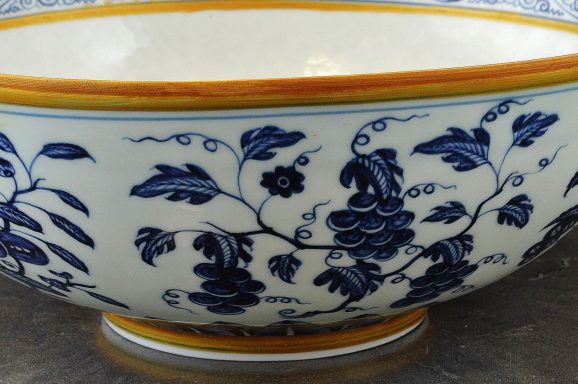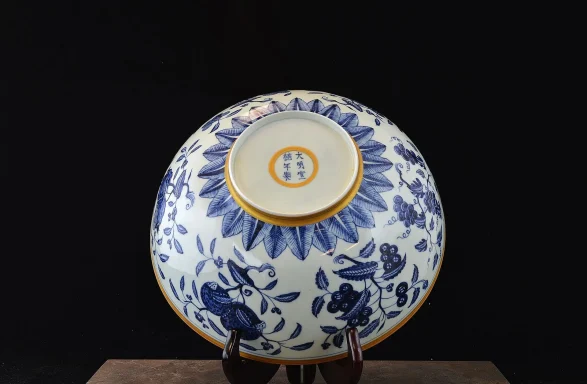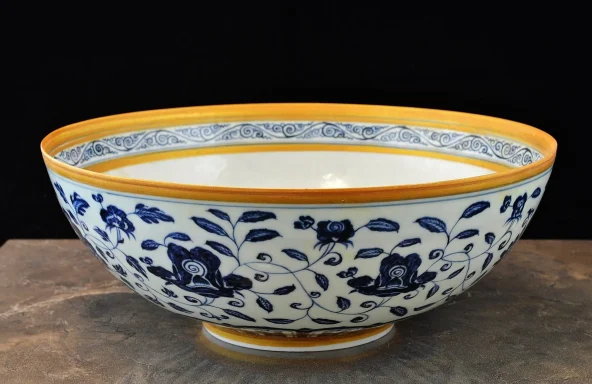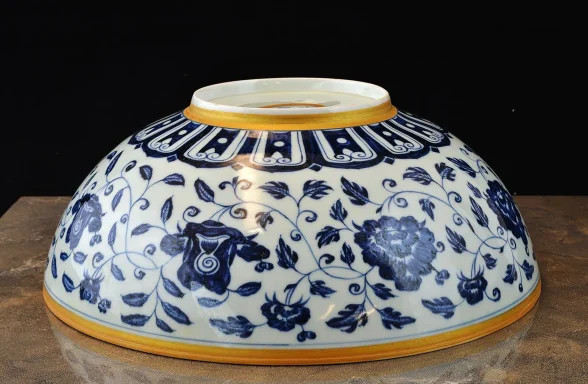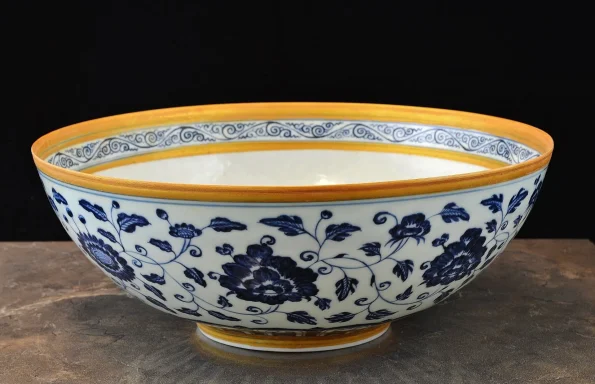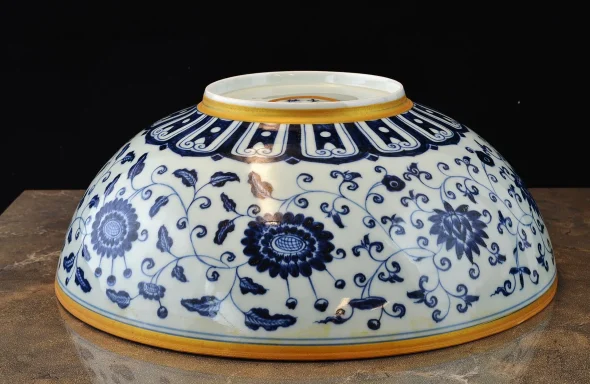Remarkable and Esteemed Imperial Porcelain from the Ming Dynasty
The Ming dynasty is renowned for its exceptional ceramics, particularly the cobalt blue-and-white porcelain crafted in locales such as Jingdezhen in Jiangxi province. Highly esteemed by collectors, Ming porcelain has significantly impacted the ceramic arts of numerous countries globally.
Click images to expand and enlarge

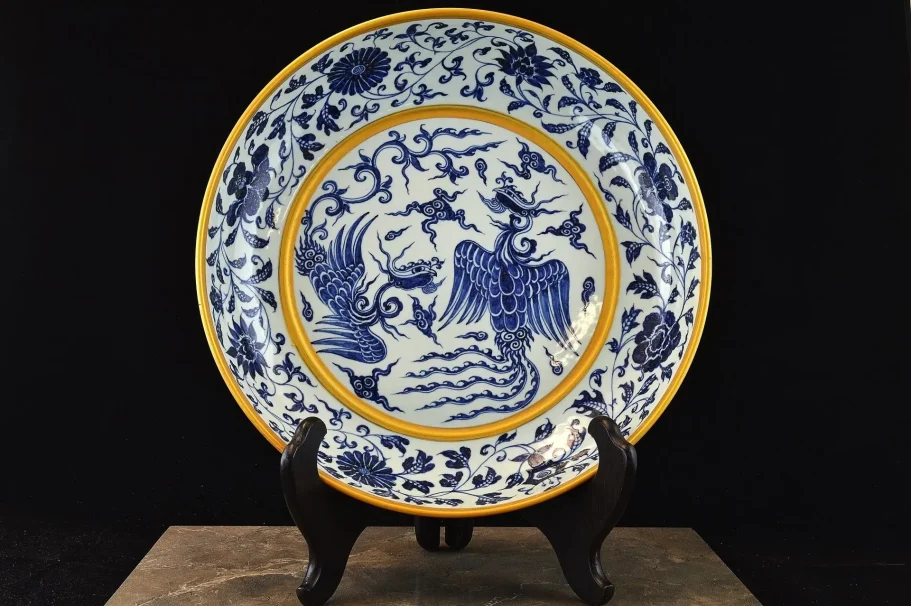
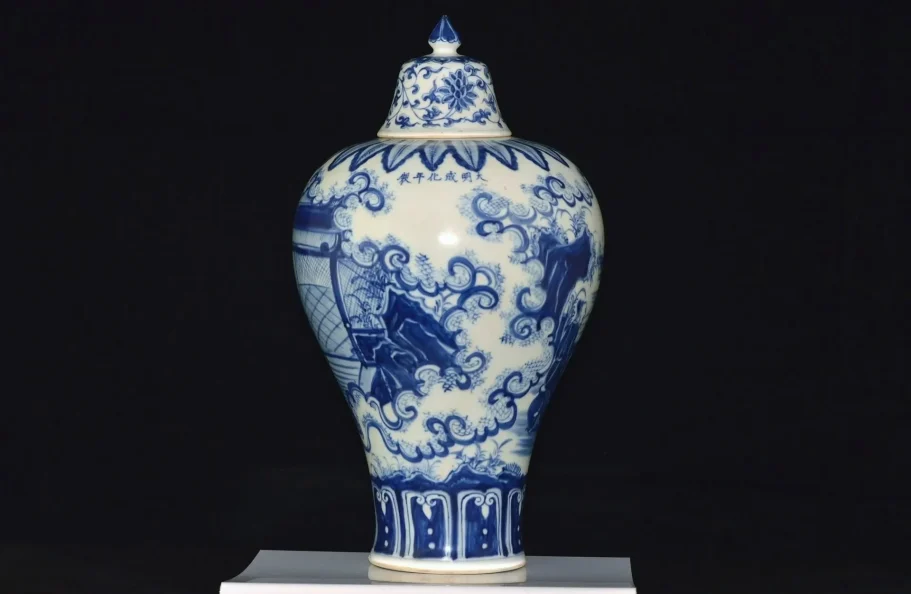
Significant Imperial Blue and White Jar from the 15th Century Ming Dynasty,
Chenghua Mark and Period
This exquisite artifact, known as the Blue and White Ming Dynasty Chenghua Mark and Period Imperial Buddhist Lion Jar, exemplifies the artistry of the Chenghua period, which spanned from 1465 to 1487. Measuring approximately 5 1/8 inches in height, this jar is a quintessential representation of the highly coveted Chenghua wares. Its delicate craftsmanship showcases an extraordinary level of skill and precision that truly merits in-person observation to fully appreciate the artistic mastery involved in its creation during the Ming Dynasty. Upon consulting auction catalogs, scholarly texts, and museum collections, one will find it difficult to locate a comparable example of a Chenghua Jar available in the marketplace. The jar features a sophisticated form and vibrant coloration, adorned with remarkably controlled freestyle brushwork, executed with what appears to be minimalistic hairbrush strokes. This attention to detail is emblematic of the finest Chenghua wares. The decorative motifs include four Buddhist Lions and various Buddhist symbols. An examination through a jeweler’s loupe reveals noticeable flaking in the biscuit, an indicator of the jar's significant age. Among Chinese ceramics, blue and white wares from this period are among the most sought after, distinguished by the stunning cobalt blue hues that are characteristic of Chenghua production. The cobalt utilized during this dynasty has a distinct blackish tone, derived from imported Samali blue cobalt believed to have originated in Persia, though the specific source remains uncertain and has not been imported for over five centuries. In addition, local cobalt known as Pitang was employed. The mixing of these two cobalt types resulted in a refined palette of colors that defined the aesthetic quality of Chenghua wares. Artisans of this period skillfully painted fine outlines filled in with broad brushstrokes, demonstrating a unique approach to composition. The refinement of clay and the use of high-firing kilns often resulted in aesthetic peculiarities, such as a mottled appearance on the undersides of larger vessels or wavy glaze textures discernible under reflective light. This particular glaze is easily identifiable due to its fine quality and the presence of minute, even bubbles observable with a magnifying lens. In summary, the true Imperial blue and white Chenghua wares represent the pinnacle of ceramic artistry within the Ming Dynasty, and this jar stands as a testament to that legacy.
Blue and White 15th Century Ming Dynasty Xuande Mark and Period Dish Featuring Confronting Phoenixes and Floral Motifs
This exquisite 15th Century Ming Dynasty dish, designated with the Xuande mark and period, is elegantly crafted in a blue and white palette. It features a meticulously painted design that includes phoenixes, floral motifs, foliage, and fruit. This remarkable artifact is further enhanced by gilt trim accents, which underscore its artistic value. The dish is embellished with imported Samali blue cobalt, which is noted for its distinctive blackish hue. The unique piling effect on the surface glaze reveals dark spots or a silvery sheen, elements that authenticate the piece and differentiate it from the brown undertones associated with locally produced Chinese cobalt. Such characteristics affirm the dish's historical provenance, as this specific type of cobalt has not been utilized for over five centuries. Furthermore, noticeable flaking in the biscuit layer adds to the dish's historical significance, confirming its age and authenticity. The dish measures approximately 14 1/8 inches in diameter, making it a substantial specimen for collectors and connoisseurs alike. ppjrs
Significant Imperial Blue and White Meiping Story Vase from the 15th Century Ming Dynasty, Chenghua Mark and Period
This exceptional masterpiece represents a Blue and White Meiping Story Vase from the Chenghua period, marked and produced during the reign of the Ming Dynasty, specifically between 1465 and 1487. The vase stands approximately 13 3/4 inches tall. For collectors and connoisseurs, it is advisable to reference auction catalogs, scholarly texts, and museum collections, as it is unlikely that a comparable Chenghua Meiping vase has been published or exhibited elsewhere. The vase showcases a remarkable form and vibrant color, adorned with expertly executed freestyle brushstrokes characteristic of the finest Chenghua ceramics. The blue and white wares produced during this esteemed period are among the most coveted examples of Chinese porcelain. The exceptional cobalt pigment utilized is a distinguishing feature, providing a unique blackish tone derived from imported cobalt, believed to be samali blue from Persia. This specific cobalt has not been imported for over five centuries, marking the rarity of such pieces. In addition, a local cobalt known as Pitang was employed, with the combination of both pigments yielding a variety of refined hues. Chenghua artisans were notable for their meticulous use of fine outlines filled in with broad strokes. The refinement of clay and the high-temperature kilns of this era contributed to distinct characteristics, including occasional burning or mottling visible on the unglazed bottoms of larger vessels. When glazed, some bottoms may exhibit a wavy appearance, particularly under light. This particular glaze is exceptionally fine, featuring tiny, uniform bubbles identifiable through the use of a loupe, further confirming its authenticity and age. The presence of flaking in the biscuit underscores the vase's historical significance. It is a testament to the pinnacle of Imperial blue and white Chenghua wares, a category unparalleled in its artistry and quality.
Exceptional Cloisonné Jar and Lid with Fish Motif from the Ming Dynasty,
Mark and Period of Jiajing
This exceptional Jiajing Cloisonné Fish Jar with Lid, distinguished by its remarkable rarity and importance, originates from the Ming Dynasty. The Jiajing period, spanning from 1522 to 1566, is renowned for its exquisite Fish Jars, and this particular piece exemplifies the mastery of cloisonné craftsmanship. The jar exhibits minor flaking in the biscuit, a testament to its historical authenticity. This extraordinary work of art stands at an impressive height of 15 1/2 inches. ppjrs
Imperial Blue and White Ming Dynasty Jiajing Mark and Period Jar and Lid Featuring Fish Amidst Aquatic Vegetation
This exceptional jar, originating from the Ming Dynasty and specifically produced during the Jiajing period (1522-1566), is a finely crafted blue and white Guan jar featuring a motif of fish among aquatic weeds. Notably, the Jiajing era is characterized by the use of imported Mohammedan blue cobalt, which was distinguished by its unique purple hue and became increasingly scarce by the early 17th century. The jar displays evidence of age through flaking in the biscuit, enhancing its authenticity and historical significance. This exquisite piece stands at a height of 15 1/4 inches. ppjrs
Imperial Blue and White Early 15th Century Ming Dynasty Xuande Period Dragon Motif Globular Vase with Extensive Inscriptions
Ming Dynasty Xuande, Early 15th Century, Blue and White Globular Vase Featuring a Dragon and Extensive Inscription. This exquisite globular vase showcases a five-clawed dragon gracefully soaring through the clouds in pursuit of a flaming pearl. The vase is adorned with imported Samali blue cobalt, renowned for its distinctive blackish hue. Notably, the heaping and piling effects on the surface of the glaze may reveal black spots or silvery reflections; conversely, any brown coloration would indicate the use of local Chinese cobalt. This distinction serves as evidence of its age, as imported cobalt has not been accessible for over 500 years. Furthermore, the presence of flaking in the biscuit reinforces the vase’s historical significance. The dimensions of this Xuande globular vase are approximately 17 3/8 inches in height. ppjrs
Imperial Blue and White Ming Dynasty 15th Century Chenghua Windswept Mark and Period Figure Jar
This exceptional piece is a noteworthy example of an Imperial Ming Dynasty blue and white guan jar, specifically dating back to the 15th century and marked from the Chenghua period (1465-1487). The jar features four distinct decorative panels: the first showcases lotus leaves; the second depicts water with horses soaring amidst clouds; the principal panel illustrates a narrative scene accompanied by a six-character Chenghua mark; while the base presents a water-themed design. The craftsmanship is evident in the dynamic portrayal of the figures, particularly the flowing robes that suggest movement in the wind. Furthermore, the original method of joining the jar can be discerned from visible luting marks. The base exhibits a mottled appearance, indicating a degree of burning during the firing process. The overall height of the piece is approximately 11 3/4 inches. Chenghua blue and white ceramics are renowned as the most desirable examples produced in China, distinguished by the exquisite cobalt blue pigment characteristic of this era. The cobalt used is notable for its distinct blackish hue, derived from imported Somali blue cobalt, which was blended with locally sourced cobalt called Pitang to enhance stability, minimizing the risk of color running. Unlike vessels from previous periods, Chenghua ceramics typically avoid the heaping and piling effects due to the meticulous refinement of their cobalt. This cobalt, historically sourced from Persia, has not been imported into China for over five centuries since the conclusion of the Chenghua period. Chenghua wares are recognized for their fine outlines and broad brush strokes that exhibit a spontaneous style. The clay composition was superior to that of earlier periods, and the use of high-firing kilns resulted in larger pieces often showcasing unglazed bottoms with a burnt or mottled finish, while glazed bases may appear undulating. Upon close inspection, the glaze displays a uniform surface with minute bubbles visible under magnification. This particular piece also demonstrates signs of flaking in the biscuit body, further confirming its age and authenticity.
Imperial Pair of Blue and White Vases from the 15th Century Ming Dynasty, Marked and Period Chenghua
This exceptional pair of Blue and White Ming Dynasty Meiping vases, marked and produced during the Chenghua period (1465 - 1487), exemplifies the pinnacle of Imperial craftsmanship. The vases feature an elegant form and striking coloration, adorned with meticulously controlled brushwork that is characteristic of the finest Chenghua ceramics. Upon close inspection, flaking within the biscuit is evident, observable through a loupe, indicating the substantial age of these vases. Renowned for their desirability, these blue and white wares represent the most coveted examples produced in China’s history. The distinctive cobalt hue employed during the Chenghua period sets these pieces apart from others, showcasing a unique blackish tone derived from the imported cobalt known as Samali blue, believed to have origins in Persia, though its exact provenance remains uncertain. This particular cobalt source has not been utilized for over five centuries. Additionally, during the Chenghua period, a local cobalt pigment known as Pitang was also used. The tendency of the imported cobalt to run prompted artisans to achieve color stability by blending it with local varieties, resulting in a refined palette. Chenghua wares are notable for their delicate outlines and expansive brush strokes, a technique that reflects an evolution in artistic expression. The refinement of clay during this era surpassed previous periods, and the high-temperature kilns employed often resulted in a burnt or mottled appearance on the unglazed bottoms of many vessels. Those with glazed bottoms exhibit a wavy texture, particularly visible when illuminated. The glaze of these vases is particularly noteworthy for its fine quality and uniform bubble formation, detectable under magnification. It is important to recognize that true Imperial blue and white Chenghua wares represent the zenith of this illustrious tradition. These Meiping vases stand at a height of 7 ½ inches. ppjrs
Imperial Chenghua Sweet White Porcelain Plate from the 15th Century Ming Dynasty, Featuring Subtly Impressed Dragon Mark and Period
This plate, an exceptional example of 15th-century Ming Dynasty Chenghua Sweet White Porcelain, features a discreetly impressed dragon design at its center, visible only in light reflections. The plate exhibits flaking in the biscuit, further attesting to its age and authenticity. Its dimensions are approximately 14 1/4 inches in diameter. ppjrs
An Exquisite Chenghua Period Palace Bowl with Ming Dynasty Mark
Featuring Okra Plant Motif
**Very Fine Mark and Period Chenghua Palace Bowl** This exquisite Chenghua Palace Bowl features the highly sought-after samali blue cobalt, a characteristic pigment distinguished from contemporary Chinese cobalt by its unique coloration, originating from the Yuan and early Ming dynasties. The craftsmanship involved in Chenghua wares is noteworthy; artisans expertly refined the cobalt, eliminating the heaping and piling that often disrupts the surface glaze. Additionally, they blended imported cobalt with local Pitang cobalt, resulting in a remarkable array of refined color tones. It is important to note that the imported cobalt utilized in these wares has not been available for over five centuries, rendering any modern imitation impossible. Serious collectors should possess a keen understanding to accurately identify these pieces. The artistry exhibited by Chenghua potters in their refinement of imported cobalt produces a spectrum of beautiful tones that are easily recognizable compared to items from other periods. This particular bowl exhibits flaking in the biscuit, confirming its considerable age. It is currently available for purchase and measures approximately 5 5/8 inches in diameter. Should you have any inquiries regarding this remarkable bowl, please do not hesitate to reach out. ppjrs
An Exquisite Ming Dynasty Chenghua Marked Palace Bowl
Featuring Peony Motifs
**Exquisite Chenghua Palace Bowl with Fine Marking and Period Significance** This exceptional bowl features intricate decoration, showcasing rocks, peony plants, and floral motifs. Notably, the samali blue cobalt utilized during the Yuan and early Ming dynasties possesses a unique hue that markedly differs from contemporary Chinese cobalt. Chenghua wares exhibit remarkable refinement in cobalt processing, avoiding the heaping and piling that often disrupt the surface glaze. Furthermore, the artisans skillfully blended imported cobalt with locally sourced Pitang cobalt, resulting in a sophisticated color palette. It is important to emphasize that the imported cobalt used in this period has not entered the market for over five centuries, thus rendering it inimitable. Collectors must possess a discerning eye to appreciate the nuances of these pieces. The refinement of imported cobalt during the Chenghua period lends to the wares a spectrum of beautiful tones, making them easily distinguishable from works of other eras. This bowl displays flaking in the biscuit, which further attests to its age and authenticity. This remarkable piece measures 5 3/4 inches in diameter and is currently available for sale. For further inquiries regarding this splendid bowl, please do not hesitate to contact me. ppjrs
15th Century Ming Dynasty Chenghua Mark & Period Imperial Doucai
Porcelain Phoenix Tian Jar
This exquisite doucai Tian jar, marked and produced during the Chenghua period of the Ming Dynasty, is a remarkable antique featuring a phoenix in flight amidst peonies and floral scrolls. The term "doucai" refers to the technique of using contrasting colors, characterized by underglaze blue outlines complemented by a harmonious application of colored enamels, embodying the whimsical style of Chenghua artisans. The craftsmen of this era were known for their innovative use of colors and techniques. Notably, the underglaze blue employed in this piece is derived from an imported cobalt known as Samali blue, blended with local pitang cobalt. This combination resulted in the creation of an exceptionally refined cobalt blue, which is easily distinguishable from other cobalts used in Chinese ceramics. The Samali blue has not been imported for over five centuries, and its precise origins in Persia remain uncertain. High-temperature firing was utilized during the production of this jar, often resulting in a brownish hue on the foot ring and a slightly undulating base that can appear varied in different lighting conditions. Furthermore, the presence of flaking in the biscuit adds to the jar’s authenticity and age. The base of the jar bears the Tian mark, which translates to "Heaven." The Chenghua period is widely regarded as the zenith of the doucai technique in Chinese ceramic history. This Ming Dynasty Chenghua Period Tian jar, featuring a majestic phoenix, stands at an approximate height of 5 3/8 inches. ppjrs
Imperial Doucai Porcelain: 15th Century Ming Dynasty Chenghua Mark and Period Tian Jar Featuring Mythical Creatures
This exceptional doucai Tian Jar from the Ming Dynasty, attributed to the Chenghua Mark and Period, features mythological creatures gracefully soaring among clouds above water. The term "doucai" refers to the artistic technique that utilizes contrasting colors. In this instance, underglaze blue outlines are meticulously filled with colored enamels, resulting in a composition that is both harmonious and aesthetically pleasing, characteristic of the whimsical style of Chenghua artisans. During this period, craftsmen experimented with various colors and techniques, achieving remarkable results. Notably, the underglaze blue is composed of imported cobalt known as Samali blue, mixed with locally sourced cobalt known as pitang. This unique combination produced what is widely regarded as the most exquisitely refined cobalt blue in Chinese history, making it easily distinguishable from other cobalt variations utilized throughout China's ceramic production. It is important to note that the importation of Samali blue ceased over 500 years ago, and its origin in Persia remains uncertain today. The jar showcases evidence of high-temperature firing, which often results in a distinct brownish hue on the foot ring; variations in the base can also be seen under certain lighting conditions. Additionally, the presence of flaking in the biscuit signifies the jar's considerable age. The base of the jar is marked with the character "Tian," symbolizing "Heaven." The Chenghua period is recognized as the zenith of the doucai technique, and this Ming Dynasty Chenghua Period Tian Jar stands at an approximate height of 5 inches, embodying the artistry and sophistication of its time. ppjrs
Imperial Blue and White Brush Washer from the Chenghua Period
of the 15th Century Ming Dynasty
This exquisite incised black-and-white brush washer from the Ming Dynasty, specifically the Chenghua period, exemplifies the artistry and craftsmanship of its time. The piece is intricately painted in a wave motif with detailed depictions of mythical creatures above the water’s surface, showcasing the high level of skill involved. The brush washer stands approximately 5 9/16 inches tall and is representative of the Chenghua period, which spanned from 1465 to 1487. Chenghua blue and white wares are among the most coveted porcelain produced in China, distinguished by the quality of cobalt used during this era. The cobalt, noted for its rich, blackish hue, differs from that of other periods due to the incorporation of imported Somali cobalt mixed with locally sourced pitang to prevent running—a notable concern during production. The refinement of cobalt during the Chenghua period resulted in exceptionally smooth glazes, devoid of the heaping and piling that frequently marred pieces from earlier periods. The imported cobalt originated from Persia, though its specific source remains unidentified. Since the conclusion of the Chenghua period over five centuries ago, no similar cobalt has been imported into China. Chenghua wares feature meticulously outlined designs, filled in with broad brush strokes that exhibit a relaxed, free style. The clay was more finely refined than in previous periods, and the use of high-temperature kilns often resulted in unglazed bottoms appearing burnt or mottled, while glazed bottoms may show waviness, also has flaking in the biscuit, further corroborating their age. A thorough examination reveals tiny, even bubbles within the glaze, observable with a loupe. The presence of flaking in the biscuit also attests to its historical significance. Thus, it is asserted that authentic Imperial blue and white Chenghua wares represent the pinnacle of porcelain craftsmanship.
Imperial Blue & White Early 15th C. Ming Dynasty Yongle Marked and Period
Dragon Globular Formed Vase
Ming Dynasty Blue & White Yongle Vase (1403-1424) – Marked Period, Globular Form This exquisite globular vase, originating from the esteemed Yongle period of the Ming Dynasty, features a meticulously rendered three-clawed dragon, poised elegantly amid stylized waves. The cobalt blue pigment used in its creation is imported samali blue, characterized by a distinctive blackish tone. Notably, the heaping and piling effect that occurs during glazing results in the appearance of black spots or a silvery sheen. Conversely, if brown hues emerge, this indicates the use of locally sourced Chinese cobalt, thereby reinforcing the vase's authenticity and historical significance, as imported cobalt has not been available for more than five centuries. Additionally, evidence of flaking in the biscuit further substantiates its age. The vase is adorned with a four-character mark on the neck and stands approximately 17 inches in height. ppjrs
Imperial Blue and White 15th Century Ming Dynasty Vase with Xuande Mark Featuring Dragon Motif
This exquisite 15th-century Ming Dynasty Xuande Dragon Flask, marked with the period designation from 1426 to 1435, exemplifies the artistry of its era. The vase features a stunning design of two dragons, poised in the water, accompanied by an intricate cloud pattern overhead. The Xuande six-character mark is prominently displayed on the shoulder of the vase, signifying its authenticity. Crafted using imported samali blue cobalt, the coloration presents a distinctive blackish tone. The heaping and piling technique employed during production often reveals either black spots or a silvery sheen on the surface of the glaze. In instances where brown hues are exhibited, it indicates the usage of locally sourced Chinese cobalt. This characteristic is critical for confirming the vase's age, as imported cobalt has not been available for over five centuries. Additionally, the presence of flaking in the biscuit further substantiates its historical significance. This remarkable vase stands approximately 17 5/8 inches tall, making it a noteworthy addition to any collection of fine antique Chinese ceramics. ppjrs
Imperial Blue & White 15th C. Ming Dynasty Xuande Marked and Period
Dragon Meiping Vase
Blue and White 15th Century Ming Dynasty Meiping Vase with Xuande Mark and Period Dragon Motif This exceptional Meiping vase features a meticulously rendered dragon with four claws and is constructed in two sections. Due to its substantial size, the vase was fired on a setter, resulting in the characteristic cross mark on the base. The artisans employed imported Samali blue cobalt, distinguished by its dark, blackish hue. The heaping and piling technique employed in glazing has produced a surface effect that displays both black spots and silvery reflections. In contrast, brown hues would indicate the use of locally sourced Chinese cobalt, thereby signaling a more recent production. The presence of such characteristics not only confirms the vase's authenticity but also signifies that imported cobalt has not been available for over five centuries. Additionally, the noticeable flaking in the biscuit serves as further evidence of its age. This Meiping vase stands approximately 17 inches tall. ppjrs
Imperial Blue and White 15th Century Ming Dynasty Stem Cup with Xuande Mark and Period Decoration Featuring a Winged Mythical Creature
Blue and White Stem Cup from the 15th Century Ming Dynasty, featuring the Xuande mark and characteristic winged mythical creatures. This exquisitely painted stem cup showcases four-clawed mythical animals soaring amidst clouds, with the Xuande mark located on the interior. Crafted using imported samali blue cobalt, this material is distinguished by its blackish hue. The accumulation and layering effects on the surface of the glaze reveal black spots or a silvery sheen, rather than the brown typically associated with local Chinese cobalt. This characteristic helps authenticate its age, as this specific cobalt has not been available for the past 500 years. Additionally, the presence of flaking in the biscuit further corroborates its historical significance. The dimensions of this stem cup are approximately 7 inches in diameter and 4.5 inches in height. ppjrs
Imperial Blue and White Flask from the 15th Century Ming Dynasty, Showcasing the Xuande Period Mark and Distinct Depiction of Dragon and Phoenix Motifs.
Blue and White Flask from the 15th Century Ming Dynasty, featuring the Xuande mark and depicting Dragons and Phoenixes intertwined with peony scrolls and floral motifs. This rare, uniquely shaped flask is adorned with five-clawed dragons and includes a six-character mark on the shoulder. The piece utilizes imported samali blue cobalt, characterized by a distinct blackish hue. Notably, the heaping and piling effect of the glaze reveals black spots or reflective silvery tones, which differentiates it from local Chinese cobalt that would exhibit a brownish color. This particular cobalt has not been obtainable for the past 500 years, further corroborating the flask's authenticity and age. Additionally, evidence of flaking in the biscuit material reinforces its historical significance. This Dragon and Phoenix Flask stands approximately 15 inches in height. ppjrs
Significant Imperial Blue and White 15th Century Ming Dynasty Xuande
Mark and Period Eggshell-Thin Bowl
This exceptional Blue and White bowl, originating from the 15th-century Ming Dynasty under the Xuande period, showcases a refined eggshell-thin construction, meticulously painted with intricate depictions of fruit and foliage. The bowl is further enhanced with gilded trim, adding an element of sophistication to its overall presentation. Crafted utilizing imported Samali blue cobalt, the pigment exhibits a distinctive blackish hue. Notably, when the glaze surface experiences variations due to the heaping and piling effect, it reveals black spots or a silvery sheen—characteristics that differentiate it from local Chinese cobalt, which would present a brownish tint. This specific cobalt has not been available for over 500 years, serving as a testament to the bowl’s historical authenticity. Additionally, the presence of flaking in the biscuit layer further substantiates the age of this remarkable piece. The bowl measures approximately 11 3/4 inches in diameter. ppjrs
Significant Imperial Blue and White 15th Century Ming Dynasty Xuande Mark and Period Eggshell Thin Floral Bowl
This exquisite blue and white bowl, originating from the Xuande period of the 15th-century Ming Dynasty, displays the artistry and craftsmanship of its time. The bowl features a delicate eggshell-thin construction, adorned with intricate depictions of flowers, vines, and leaves. It is further enhanced by gilt trim, adding a touch of elegance to its overall design. The bowl is painted with imported Samali blue cobalt, notable for its distinctive blackish tone. This characteristic is particularly evident where the heaping and piling effects disrupt the glaze, revealing black spots or a silvery reflection, rather than the brown associated with locally sourced Chinese cobalt. This specific type of cobalt has not been available for over 500 years, serving as a critical indicator of the bowl's authenticity and age. Additionally, observations of flaking in the biscuit layer further substantiate its historical significance. The bowl has an approximate diameter of 11 3/4 inches, making it a striking centerpiece for any collection. Its combination of age, materials, and craftsmanship exemplifies the sophistication of Ming Dynasty porcelain. ppjrs
Significant Imperial Blue and White 15th Century Ming Dynasty Xuande Mark and Period Dish Featuring Birds and Floral Motifs
Blue and White Dish from the 15th Century Ming Dynasty, Featuring Xuande Mark and Period Decoration with Birds and Floral Motifs. This exceptional piece has been meticulously adorned with gilt trim. It showcases imported samali blue cobalt, characterized by a distinctive blackish hue. Notably, the piling effect that disrupts the surface of the glaze reveals black spots or a silvery sheen, contrasting with the brown typically produced by local Chinese cobalt. This particular composition attests to its authenticity, as such cobalt has not been sourced for over 500 years. Additionally, the presence of flaking in the biscuit further substantiates the age of this remarkable artifact. The dish measures approximately 14 1/8 inches in diameter. ppjrs
